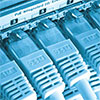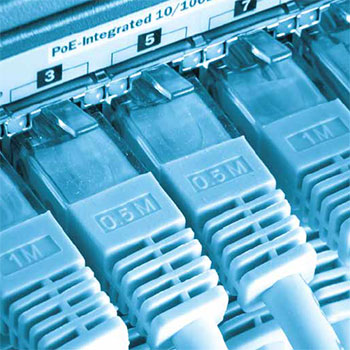
A Brave New World
Power protection is significant in the networking and IP camera space
- By Samantha Wade
- Aug 01, 2014
 Standing as arguably one of the most important
foundational elements of any security
system, the presence of adequate power and
the protection of that power are critical. While
businesses will spend thousands of dollars
on cameras and recording systems, alarms,
intrusion detection, emergency communication and theft prevention,
many overlook the need for systems’ power protection.
Standing as arguably one of the most important
foundational elements of any security
system, the presence of adequate power and
the protection of that power are critical. While
businesses will spend thousands of dollars
on cameras and recording systems, alarms,
intrusion detection, emergency communication and theft prevention,
many overlook the need for systems’ power protection.
Similar to an individual buying a top safety-rated car with the
latest safety advances but neglecting to buy car insurance, even
security systems need protection. Because of our technological
age, all systems require power to operate, and to protect a business
and its personnel. Thus, without power, there is no security.
IP/Network Integration in Security
The shift from analog to digital, and the increased presence of
networking capabilities in the security industry, means that systems
are becoming increasingly integrated and therefore bigger,
more complex and more widely distributed.
In the days of analog, systems were separate. For example,
a business would employ the use of a power protection device,
such as UPS, for each specific system. This could include cameras
and DVRs, access control systems and theft prevention measures,
all protected separately using an individual device. This allowed
businesses to employ inexpensive power solutions with lower
quality and shorter runtime because managers only needed to
power one unit just long enough to have a technician available to
service the devices.
With the shift toward digital and IP, systems have become
more integrated into IT networks and are more complex. Instead
of having one unit per system, businesses can connect multiple
systems, such as NVRs, cameras and servers, all to one UPS. This
shift has led to increased power demands in the security space,
along with the need for increased battery backup time. In this
new configuration, businesses must consider the availability of
power to the network.
Power Problems
The increasing age of the power infrastructure along with everincreasing
demand for power has led to significant increases in
power problems. The five most common power problems—blackouts,
brownouts, sags/surges, spikes and line noise—create the
potential for data loss and equipment damage, exposing organizations
to both safety issues and potential liabilities.
While blackouts, a complete loss of power, are often foremost
on people’s minds, brownouts account for 88 percent of all power
problems. Sags and surges, short duration change in voltage
levels, are less common but can cause data loss and catastrophic
hardware damage. Finally, line noise, a high frequency interference
appearing in the AC line, can result in corrupted data, peripheral
lockups, semiconductor damage and shortened equipment
life spans.
The Importance of Protecting
Security Equipment
While power protection is a valuable asset in most business
applications, in the security industry, it is absolutely essential.
When a security system goes down, it becomes a far greater issue
than just downtime—the safety of both life and property hang
in the balance.
Power protection devices are broken into two main types,
surge protection and uninterruptible power supply (UPS) systems,
each varying in features and components.
The most basic level of power protection is the surge protector.
These products are designed to protect non-critical equipment
that will not be required during a power outage. These devices
ensure attached equipment is protected from catastrophic
damage caused by surges and spikes.
A step up from surge protection is the UPS, or uninterruptible
power supply. UPSs, also called battery backups, protect against
all types of power problems with the added bonus of keeping
equipment up and running. Without battery backup in place,
in the event of a power anomaly, security systems and business
could be vulnerable.
There are three levels of UPS, each increasing in price and
protection capabilities:
Standby. This is the most basic type of UPS. It is essentially
a surge protector with a battery. In the past, this inexpensive
option has been the go-to choice for small load (400-900VA)
security devices. When a power anomaly is detected, the UPS
switches over to battery power until normal power is restored.
These systems are extremely cost-effective, but cannot handle
larger systems or loads.
Line interactive. This type of UPS represents the middle
ground. It uses an automatic voltage regulator (AVR) to extend
battery life and overall efficiency. For IP security, line interactive
UPSs are the starting point for protection due to their increased
capacities—750-3000VA—and more extensive features. Line interactive
units are available in both tower and rack-mountable
formats, making them ideal for integration in a security closet or
in the updated rack environment alongside network equipment.
Online. Representing the crème de la crème of power protection,
the online UPS only has one option for the current going
into it: double conversion. Simply put, the UPS passes current
through an AC-to-DC-to-AC process, ensuring complete power
conditioning and the utmost power quality.
In the security realm, these units can provide backup capacity
for facility-wide surveillance systems, and can be used to backup
both network communications and security equipment. These
types of systems are often required for critical devices, such as
fire and emergency communications equipment, because of their
fail-safe nature.
UPS Output Types:
Sine Wave vs. Simulated Sine Wave
Not all power is created equal. UPSs can output square wave,
simulated sine wave and true sine wave power. While each wave
alternates between positive and negative to create a current, the
three are vastly different.
Square waves are typically produced by lower-end equipment,
and despite cost benefits, may put strain on the connected equipment
that can lead to operational problems.
The next step up is a compromise between power quality and
cost with a simulated sine wave. While this type of wave is still
less than ideal, the shape of the wave more closely resembles utility
power, which is a pure sine wave, therefore offering a better
quality current.
Finally, the best power quality comes from pure sine wave
UPSs. This is the ideal output for mission critical equipment in
terms of performance and longevity. Line interactive and online
UPSs are available with true sine wave output.
Increased Efficiency
As the shift toward more integrated systems continues, the need
for multiple power protection solutions has decreased, making
power usage levels and the management of these systems more
efficient. One UPS protecting a rack full of devices instead of
multiple units attached to multiple systems simplifies any security
manager’s job.
The movement to network integrated security systems, with an
ever-increasing focus on cost reduction, has shifted the overall focus
of most organizations towards efficiency. With everything connected,
businesses and managers can focus on the entire system, rather
than monitoring individual components using multiple systems.
The shift from analog to digital means that systems have become
more intertwined and complex while running on the backbone
of the IT network. Having a cohesive plan in place that
properly protects all security devices is not only critical for system
operation; it can also save a security manager’s job, should a
catastrophic power event occur.
This article originally appeared in the August 2014 issue of Security Today.